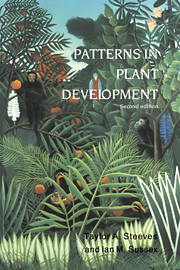Book contents
- Frontmatter
- Contents
- Preface
- Acknowledgments
- 1 Development in the vascular plants
- 2 Embryogenesis: beginnings of development
- 3 Analytical and experimental studies of embryo development
- 4 The structure of the shoot apex
- 5 Analytical studies of the shoot apex
- 6 Experimental investigations on the shoot apex
- 7 Organogenesis in the shoot: leaf origin and position
- 8 Organogenesis in the shoot: determination of leaves and branches
- 9 Organogenesis in the shoot: later stages of leaf development
- 10 Determinate shoots: thorns and flowers
- 11 The development of the shoot system
- 12 The root
- 13 Differentiation of the plant body: the origin of pattern
- 14 Differentiation of the plant body: the elaboration of pattern
- 15 Secondary growth: the vascular cambium
- 16 Secondary growth: experimental studies on the cambium
- 17 Alternative patterns of development
- Credits
- Author index
- Subject index
14 - Differentiation of the plant body: the elaboration of pattern
Published online by Cambridge University Press: 21 December 2009
- Frontmatter
- Contents
- Preface
- Acknowledgments
- 1 Development in the vascular plants
- 2 Embryogenesis: beginnings of development
- 3 Analytical and experimental studies of embryo development
- 4 The structure of the shoot apex
- 5 Analytical studies of the shoot apex
- 6 Experimental investigations on the shoot apex
- 7 Organogenesis in the shoot: leaf origin and position
- 8 Organogenesis in the shoot: determination of leaves and branches
- 9 Organogenesis in the shoot: later stages of leaf development
- 10 Determinate shoots: thorns and flowers
- 11 The development of the shoot system
- 12 The root
- 13 Differentiation of the plant body: the origin of pattern
- 14 Differentiation of the plant body: the elaboration of pattern
- 15 Secondary growth: the vascular cambium
- 16 Secondary growth: experimental studies on the cambium
- 17 Alternative patterns of development
- Credits
- Author index
- Subject index
Summary
The early stages of differentiation, considered in Chapter 13, are characterized by the blocking out of regions within which cells are relatively homogeneous and behave similarly. In contrast, the later stages of differentiation show highly localized specializations, often with adjacent cells differing markedly in the developmental changes they undergo. Therefore, in studying these stages of differentiation it is essential to pay close attention to the events taking place in individual cells, and this will be the first task. When this has been done, it will be necessary to return to the higher levels of organization to consider the interrelations that keep the differentiating cells as part of an organized system.
CELLULAR CHANGES DURING DIFFERENTIATION
In contrast to the body of higher animals with its large number of differentiated cell types, relatively few cell types, possibly no more than twelve, are differentiated in the body of the vascular plant. However, to describe the cellular events related to differentiation of even this small number of cell types would fill many pages. Rather than do this, attention will be concentrated on the differentiation of the tracheary elements of the xylem, the tracheids and vessel members, and the sieve elements and companion cells of the phloem. These differentiate in the primary body from procambium and in the secondary body from cambium, and because the sequence of differentiation is generally similar in both cases, it usually will not be necessary to make distinctions between them in the following description.
- Type
- Chapter
- Information
- Patterns in Plant Development , pp. 285 - 310Publisher: Cambridge University PressPrint publication year: 1989

